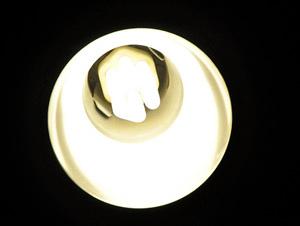Shedding light on the light bulbs debate
Energy efficient CFL light bulb. (Image by Flickr user Medill DC)
Story from Living on Earth. Listen to audio above for more.
Republican leaders in the House of Representatives pushed their latest bright idea on energy: An attempt to block efficiency standards for light bulbs. The energy act signed by President George Bush in 2007 required lighting that uses at least 27 percent less electricity.
The so-called ‘bulb ban’ has become a rallying cry for some conservatives. In recent House floor debate Texas Republicans Mike Burgess and Joe Barton argued that the rule forces consumers to use inferior products.
Barton: “Why in the world does the federal government have to tell people what kind of lights they use in their home?”
Burgess: “The American people should be able to choose what type of lightbulb they use in their home. They should not be constrained to all of the romance of a Soviet stairwell when they go home in the evening.”
In the following interview, Living on Earth’s Jeff Young gets environmental writer and blogger Brian Clark Howard to shed some light on the pros and cons of energy efficient bulbs.
YOUNG: Let’s start here with my favorite line from the House floor debate — that compact fluorescent bulbs cast a light that, “has all the romance of a Soviet stairwell.” This is a common complaint that we hear about CFLs – that the light is kind of harsh.
HOWARD: Well, I think that there are some discount CFLs that have been flooding the market in recent years and a lot of them are of a lower quality. It’s true that a lot of them have poor, what is called, color-rendering index — CRI. What I always recommend that consumers do is only buy CFLs that are Energy Star certified, because this covers a broad range of specifications of qualities of the bulb — it goes beyond energy efficiency. An Energy Star labeled bulb must turn on in a second, it also has a limit on the amount of mercury, and it must produce a minimum quality light.
YOUNG: Now, what about the mercury issue, let’s address that. A lot of people, including some members of Congress, we heard on the floor, are worried about the mercury that’s in compact fluorescents.
HOWARD: In my experience, the fear over mercury in CFLs is very overblown. The average amount of mercury in a CFL is four milligrams. It’s been dropping steadily. There’s now a number of CFLs that have one milligram of mercury or less. The average old school mercury thermometer has 500 milligrams. And an old thermostat on the wall has 3,000 or more milligrams of mercury.
YOUNG: Now tell me about other stuff that’s just coming on the market in a big way. Particularly I’m interested in LED — light emitting diodes.
HOWARD: Well LEDs are really exciting technology. They’ve actually been around for a long time. For decades they’ve been used for indicator lights in electronics. A lot of pundits think that they are really the future of lighting, and they last for an incredibly long time. In the laboratory, LEDs have lasted literally hundreds of thousands of hours.
YOUNG: What about cost? I mean, that’s really the big knock on these new forms of lighting, isn’t it? That they simply cost too much next to plain old fashioned light bulbs?
HOWARD: Efficient lighting technologies have down significantly in price. LEDs are halving in price about every year. The current generation of LEDs, the payoff period is roughly around three years, but a three-year payoff is pretty good on a product that could last eight to ten years or more. Good quality CFLs typically pay for themselves in just six months if you use the bulbs for six hours a day or more. People are more used to having bulbs very cheap but paying a lot for energy. It’s actually a lot better in the long term to pay just a little bit more for the bulb because they pay less for energy. Ninety-plus percent of the money that we spend on lighting is for the energy. In fact, the efficiency standards, one of the reasons why they were passed is specifically to help low-income Americans, because those are the ones that are most affected by energy bills. The current lighting standards, when fully implemented in 2020, will decrease the need for 33 large power plants in America. So it has a huge environmental impact.
YOUNG: And how much of our power goes to our lighting?
HOWARD: In America, about a quarter of all energy we use goes to lighting. That’s the equivalent of about $37 billion a year.
Read the full interview on the Living on Earth website.
———————————————————–
Hosted by Steve Curwood, “Living on Earth” is an award-winning environmental news program that delves into the leading issues affecting the world we inhabit. More about “Living on Earth.”
